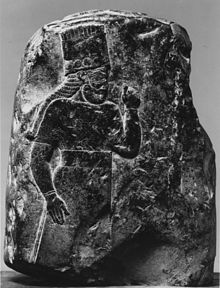Marduk-nādin-aḫḫē
Marduk-nādin-aḫḫē war 1099 bis 1082 v. Chr. König von Babylon (Isin-II-Zeit).
Ein Grenzstein (kudurru) mit einer königlichen Landschenkungsurkunde wurde 1788 von dem französischen Reisenden Antoine Michaux südlich von Bagdad entdeckt und der französischen Nationalbibliothek übergeben. Er wurde als Caillou Michaux bekannt.[1] Er war eines der ersten Keilschriftdokumente, die in den Westen gelangten. Seine ersten zwei Register zeigen Göttersymbole, darunter den gehörnten Drachen des Marduk. Darunter befindet sich eine leicht versetzt angebrachte zweizeilige Inschrift.
Literatur
- Kathryn E. Slanski: Classification, historiography and monumental authority: The Babylonian entitlement Narûs (kudurrus). In: Journal of Cuneiform Studies. Band 52, 2000, S. 95–114.
Einzelnachweise
- ↑ Kathryn E. Slanski: Classification, historiography and monumental authority: The Babylonian entitlement Narûs (kudurrus). In: Journal of Cuneiform Studies. Band 52, 2000, S. 95
| Vorgänger | Amt | Nachfolger |
|---|---|---|
| Enlil-nādin-apli | König von Babylonien 1099–1082 v. Chr. | Marduk-šāpik-zēri |
| Personendaten | |
|---|---|
| NAME | Marduk-nādin-aḫḫē |
| ALTERNATIVNAMEN | Marduk-nadin-ahhe |
| KURZBESCHREIBUNG | König von Babylon |
| GEBURTSDATUM | vor 1099 v. Chr. |
| STERBEDATUM | nach 1082 v. Chr. |
Auf dieser Seite verwendete Medien
A "kudurru," the Akkadian term for boundary stone, combines images of the king, gods, and divine symbols with a text recording royal grants of land and tax exemption to an individual. While the original was housed in the temple, a copy of the document was kept at the site of the land in question. This example was found at the temple of Esagila, the primary sanctuary of the god Marduk. The king Marduk-nadin-ahe is depicted with his left hand raised in front of his face; he wears the tall Babylonian feathered crown and an elaborately decorated garment with a honeycomb pattern. On the top are a sun disk, star, crescent moon, and scorpion, representing deities who witnessed the land grant and tax exemption. A snake-dragon deity emerges from a row of altars shaped like temple façades along the back.

